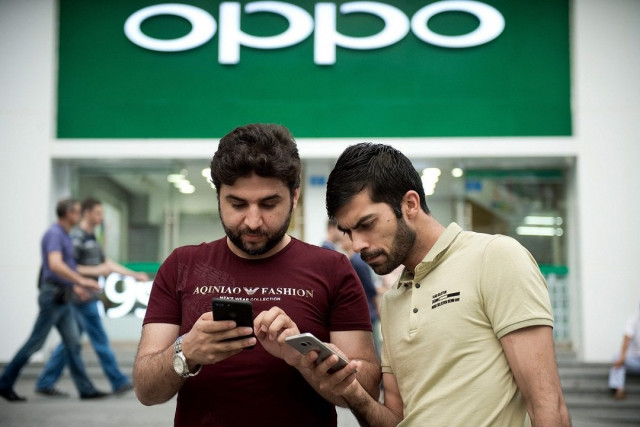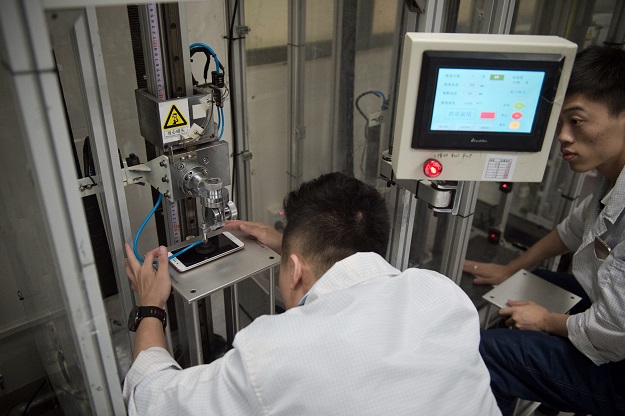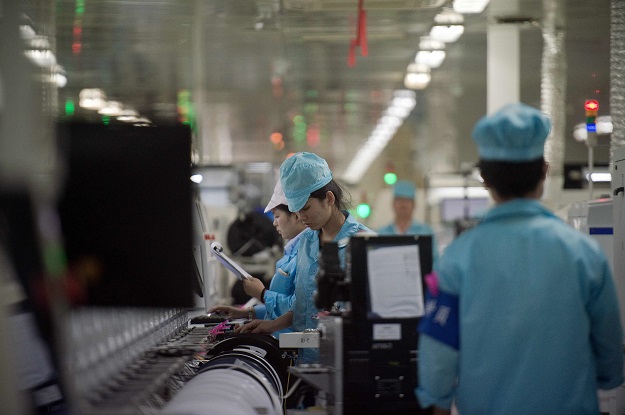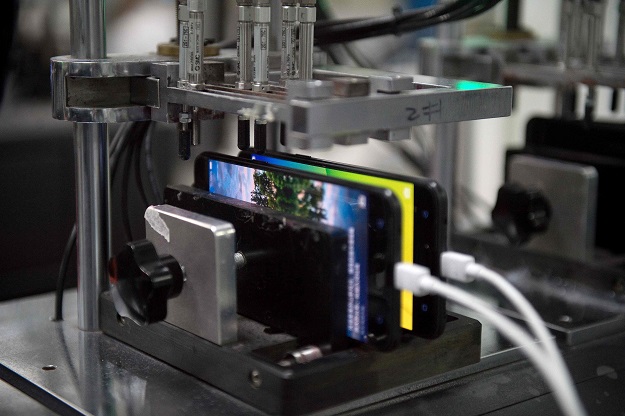After toppling Apple in China, Oppo eyes world market
The smartphone maker ranks fourth globally, behind Samsung, Apple and Huawei

Men holding smartphones stand in front of an Oppo shop in Shenzhen. PHOTO: AFP
Oppo began life selling DVD players in the in the southern manufacturing hub of Dongguan a little more than a decade ago and only broke into the handset market in 2011.
But with an aggressive marketing strategy and concentration on bricks-and-mortar stores in small and medium-sized cities -- rather than relying on online customers -- sales have soared.
Last year it had a market share of 16.8 percent making it the China market leader and while a slip in the first three months of 2017 put it just behind local rival Huawei, according to market analyst IDC, it remains well ahead of Apple and Samsung.
Globally it ranks fourth behind Samsung, Apple and Huawei.

While its rivals focus on the premium end of the smartphone market in major cities and online, Oppo makes relatively cheap devices -- its latest model is less than half the price of an iPhone 7.
Oppo also sells them in actual shops. It has 200,000 outlets across China -- less than 10 percent of its purchases are made online -- while retailers are offered generous commissions in exchange for promoting the brand.
OPPO launches the Selfie Expert F3 Plus to much fanfare
"In small cities, consumers unfamiliar with smartphones need to see and touch the devices and to have salespeople there to help them," said Yi Jun, Oppo's international sales director.
At the company's factory in Guangdong province, Oppo handsets are submitted to a series of durability tests including one-metre drops and temperature changes ranging from -40 degrees Celsius to 85 degrees Celsius.
"Technology is essential for meeting consumers' expectations," Yi said, pointing to Oppo's fast-charging ability, high-definition camera lens and sleek design.

Now Oppo's rivals are starting to follow suit.
Chinese brand Xiaomi, which lost significant market share in 2016, has been relying on the web for sales of its top-of-the-range smartphones.
But in February it announced plans to go back to old-fashioned selling techniques with plans to open 1,000 stores by 2020 in the hope of reversing its fortunes.
Which smartphone delivers the perfect selfie?
As competitors play catch up, analysts warn Oppo must maintain its momentum to stay on or near the top.
It needs to continue expanding its sales network and offering competitive products, said Mo Jia, an analyst at technology research firm Canalys.
Oppo has also been boosting its sales abroad, including emerging markets in Southeast Asia where its share more than doubled to 13.2 percent last year -- by far the biggest increase among its rivals, IDC data shows.

In India, it was the fourth-biggest player in the fourth quarter, with 8.6 percent market share, behind Samsung, Xiaomi and Lenovo.
"Its success in these countries comes from frantic marketing," said IDC analyst Tay Xiaohan, noting the use of local celebrities as "brand ambassadors" as it targets millennials.
It is also starting to back high-profile sports teams to increase brand awareness. Earlier this year it forked out more than $160 million to become an official sponsor of the Indian cricket side.
And Oppo is adapting its products to satisfy the "selfie" trend.
"We noticed the craze in Southeast Asia for group selfies and tailored our devices accordingly," Yi said, referring to special camera features that enable users to take better self-portraits.
Next stop is the West.
"We are very interested in entering the US and European markets, we are working on it... but without a precise timeline," Yi said.
It will be challenging.
While Huawei has managed to make a name for itself in US and European smartphone markets, it was already very present in those places as a telecom equipment manufacturer, said Annette Zimmermann, an analyst with technology research company Gartner.
And Oppo's direct sales strategy might not be as successful in markets dominated by mobile network operators that provide handsets with their contracts.



















COMMENTS
Comments are moderated and generally will be posted if they are on-topic and not abusive.
For more information, please see our Comments FAQ